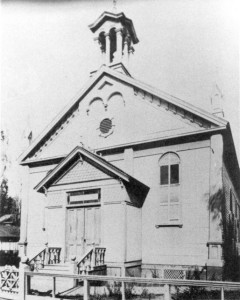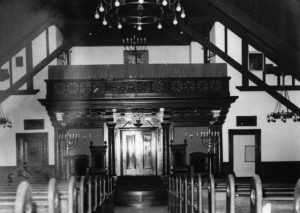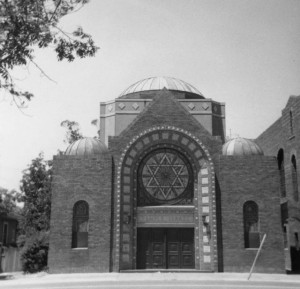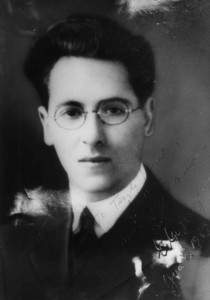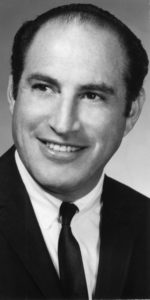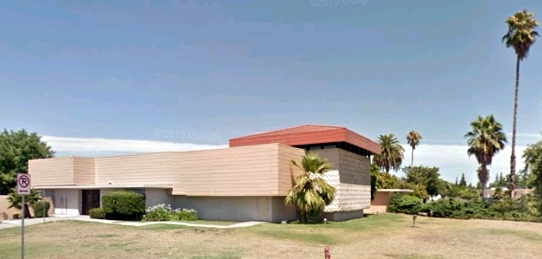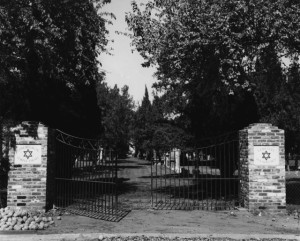Temple Israel of Stockton
The City of Stockton was founded in 1846.
Stockton was the main supplier of goods for mines between the Merced River and the Mokulumne River in California’s Gold Country.
Three early Jewish merchants were Isaac Zacharias, J. Rosenbaum, and Bernard Frankenheimer.
By 1851, Ryhim Ahoovim, a Jewish Bevevolent Society, had come into existence. (Tradition says that the Society was founded in the latter months of 1849.)
By 1851, the Society had acquired a cemetery for Jewish pioneers.
The cemetery is the oldest Jewish cemetery in continuous operation west of the Rocky Mountains.
In 1851, the Stockton Jewish community celebrated the High Holy Days at the Corinthian Theater. Jewish-owned businesses closed for the holidays.
In 1855, Ryhim Ahoovim became a congregation.
First Building
Simon R. Rosenthal was elected as the new temple’s president, and the congregation decided to build a synagogue.
Stockton’s founder, Charles M. Weber, donated a lot where Stockton’s first synagogue was built.
The lumber had to be shipped around Cape Horn since there were no sawmills in the area. It was unloaded at the Stockton waterfront, and was hauled to the building site by congregational members in order to save money.
The synagogue was completed and dedicated in 1855, with services conducted by Rabbi Julius Eckman of San Francisco.
The new congregation consisted of forty-three members.
Due to flooding in 1863, the building was moved, physically, to Hunter Street.
The building was used as Stockton’s synagogue until 1905.
In 1876, Congregation Ryhim Ahoovim made Herman Davidson its Rabbi-Cantor, a position held for twenty years. [Click here for our Rabbi-Cantor Davidson exhibit.]
In 1898, Rabbi Rudolph Farber was hired, and Herman Davidson, who had left earlier, was called back to be the cantor under Rabbi Farber.
Second Building
In 1900, Ryhim Ahoovim, now known as Temple Israel, established a fund for a new building.
In 1904, on its fiftieth anniversary, the new Temple Israel of Stockton was completed and dedicated.
In 1906, the Congregation joined the Union of American Hebrew Congregations.
From 1901 to 1929, a number of rabbis served the congregation.
Most notable was Rabbi Edgar F. Magnin, who moved to Congregation B’nai B’rith (now Wilshire Boulevard Temple) in Los Angeles, where he served for 60 years and helped grow the membership to over 3,000 families.
While in Stockton, Rabbi Magnin visited Fresno and organized Temple Beth Israel for that city.
Jewish Community Center
In 1925, Temple Israel bought two lots at Madison and Willow Streets for the construction of a Jewish Community Center.
The original temple building was moved to the new location, and covered with a brick veneer to blend in with the Community Center building.
A few years later, the old sanctuary was moved to American Street, and a new one was built to take its place next to the Jewish Community Center.
As World War II approached, members of the congregation helped refugees from Germany settle in Stockton, where they became valuable members of both the Stockton and Jewish communities. World War II saw many young men of the congregation go to war, some not returning.
Rabbi Levy also took leave to serve as an Army chaplain.
Rabbi Isaiah Zeldin, a recent graduate of Hebrew Union College, served until Rabbi Levy returned.
Rabbi Zeldin was still in Stockton in November 1945, when Temple Israel celebrated its 90th anniversary.
He, too, moved to Los Angeles, where he created, from scratch, Stephen S. Wise Temple, a Reform synagogue with day school, middle school, high school, and a membership of over 3,000 families.
The aftermath of World War II brought back Rabbi Levy.
A number of rabbis served Temple Israel until 1956, when Rabbi Bernard Rosenberg came to Stockton and remained for twenty-one years.
Third Building
In 1960, the congregation bought three acres of land at El Dorado Street and March Lane.
Temple Israel was built slowly, first with classrooms, then offices. The sanctuary was completed and the synagogue was dedicated in 1972.
Rabbi Rosenberg retired in 1976.
In 1993, Rabbi Jason Gwasdoff became the spiritual leader of Temple Israel.
Sources
- William M. Kramer, “Jewish Stock of Stockton,” Western States Jewish History 42/2&3.
- Reva Clar, “Early Stockton Jewry and Its Cantor-Rabbi Herman Davidson, Part 1,” Western States Jewish Historical Quarterly 5/2.
- Reva Clar, “Early Stockton Jewry and Its Cantor-Rabbi Herman Davidson, Part 2,” Western States Jewish Historical Quarterly 5/3.
- Mrs. David “Bea” Schwartz, “Oldest Jewish Cemetery in the West: Stockton, California,” Western Sates Jewish Historical Quarterly 1/2.
- Reva Clar and William M. Kramer, “Rabbi Edgar F. Magnin in Stockton, 1914-1915: Rehearsal for Los Angeles,” Western States Jewish History 17/2.
=====================================================
“Jews in the News”
Community Service by Stockton, California Jewry — 1857
Notice to Israelites:
Our friends of Stockton, through Mr. A. B. Blackman, deeply regretting the late occurrences at the Asylum, over which, however, they had no control, bring to the notice of their co-religionists in the State of California, that should the hand of Heaven, in its inscrutable counsel, ever afflict any of Israel’s sons or daughters, so that they should have to take refuge in the Asylum of their city, on notice being given to the Parnass, or to the Secretary of the Synagogue Raim Ahoobim (sic), they will be ready to offer every assistance, and pay every attention in their power.
— The Weekly Gleaner, San Francisco, January 30, 1857 [WSJHQ 3/1]. The occurrences referred to were the deaths of two Jewish inmates of the state mental hospital in Stockton and their interment in a gentile cemetery. Congregation Rhyim Ahoovim (now Temple Israel) of Stockton, exhumed the bodies and reburied them in the Stockton Jewish cemetery, when they were apprised of the facts.
Another Interesting Note from the 1920s
Temple Israel received a letter and donation of a bag of money from the local chapter of the Ku Klux Klan, Stockton Klan No. 3.
Part of this letter read:
While we are a White, Gentile, Protestant Organization, we are always glad to be of some service to our Brothers of the Jewish Faith.
–– Signed, Otto B. Sparks, Kleagle of the Invisible Empire
=====================================================
